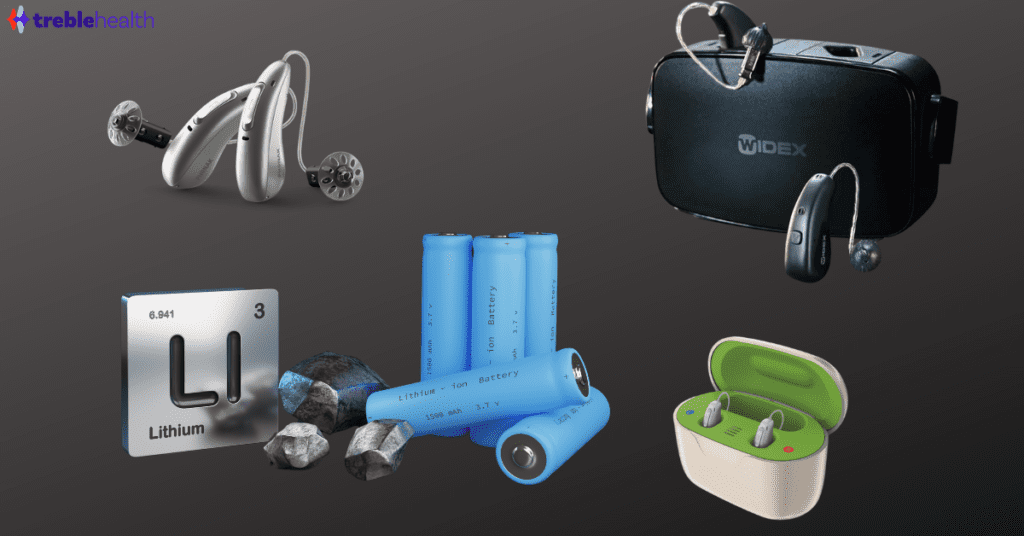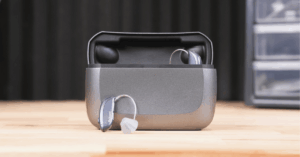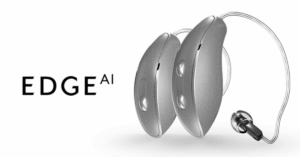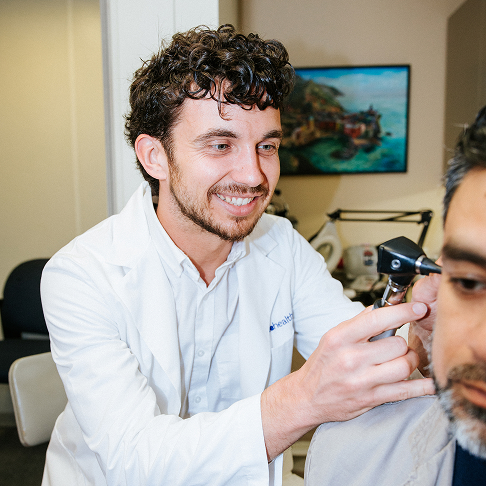Rechargeable hearing aids are often considered the best hearing aid option on the market, as they allow users to utilize their hearing aids without worrying about having to replace batteries and keep extras on hand on a regular basis. Nevertheless, it can be difficult to determine what the best rechargeable hearing aids are, and how they might best interact with your needs. We have collected the basics of rechargeable hearing aids, including the pros and cons of different types of power sources, as well as a small round up of the best devices currently on the market.
How Do Rechargeable Hearing Aids Work?
Modern hearing aids are powered by one of two types of batteries: disposable, removable “button” batteries, or rechargeable batteries that cannot be removed from the inner casing of the device. These two types are characterized by the following:
- Disposable hearing aid batteries are removable. They require replacement every few days to weeks, depending on how often the hearing aids are being used and the type of use being employed (bluetooth streaming, for instance, versus standard use).
- Rechargeable hearing aid batteries have their electrical energy restored by connection to some type of power supply. These hearing aids can be placed on a charger and typically don’t need to have a battery door, as the batteries are frequently not able to be removed at home.
As hearing aid technology improves, purchasing rechargeable hearing aids is becoming the more popular option for hearing aid users; however, some people may prefer hearing aids with disposable batteries, depending on their circumstances. Rechargeable hearing aids, for instance, might not be ideal for people who use their hearing aids for streaming constantly throughout the day, as the charge may run out and will typically require from 45 minutes to 3 hours to fully recharge.
Rechargeable hearing aids, equipped with built-in batteries, offer a convenient alternative to traditional hearing aids that use disposable batteries. These aids are charged by docking them on a charging unit overnight, similar to how smartphones are charged. This approach aligns with the growing preference for rechargeable devices over the hassle of purchasing and replacing disposable batteries.
Designed primarily for individuals with mild to moderate hearing loss, rechargeable hearing aids also come in “power” or behind-the-ear (BTE) models for those with severe or profound hearing loss. Most global manufacturers now provide these aids with lithium-ion batteries, leveraging technology common in mobile phones and other household rechargeable devices. For safety and performance, these batteries are sealed within the hearing aids, making them less susceptible to moisture, dirt, and debris, which enhances durability and consistent performance.
The move towards lithium-ion batteries is now a standard practice among leading hearing aid manufacturers, further aligning hearing aid technology with that of numerous consumer electronic products.
How Li-Ion Batteries Work
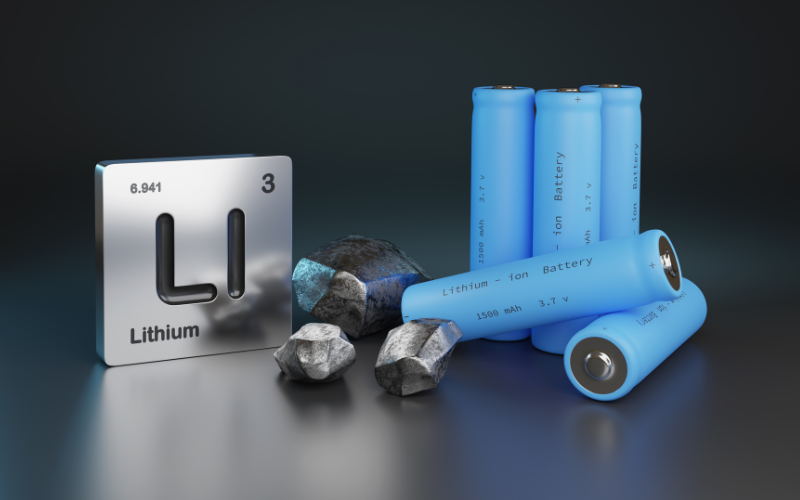
Lithium-ion batteries (also called li-ion batteries) are made up of two opposing, but never touching, electrodes. These electrodes are called the cathode and anode, which hold positive and negatively-charged ions. The cathode houses lithium, and the passage of lithium ions between these electrodes is the source of energy produced by li-ion batteries and is responsible for their battery life and consistent use. While charging, ions shift to the anode portion of the battery; while in use, they travel back to the cathode. Chemical conductors in the space between supports regular, rapid travel from side to side. The faster the ions move, the greater the heat and energy is manufactured, leading to the use of this type of battery to support long-term and regular use.
Advantages Of Rechargeable Hearing Aids
Although we have briefly touched on some of the drawbacks to rechargeable hearing aids, we would be remiss if we were not to also discuss the advantages of this particular type of hearing aid. The most commonly discussed advantages of rechargeable hearing aids include:
- Having an extended shelf life. Modern hearing aid models are capable of holding a charge for up to 30 hours and lasting about five years before requiring a replacement. However, factors like usage patterns, care practices, and environmental exposure can influence both the battery life and the longevity of the device. In contrast, disposable batteries typically need replacement every few days or weeks, depending on the type of aid and frequency of use.
- Being safer for both kids and pets. Safety is another significant benefit, especially concerning children and pets. Disposable button batteries pose a serious risk if swallowed, a surprisingly common accident. Rechargeable aids greatly reduce this risk, though it’s important to store and use all hearing aids carefully to prevent accidental swallowing or damage.
- Being environmentally friendly. Because you are recharging batteries rather than purchasing an entirely new set of batteries, there is generally less waste being created. That being said, all batteries have to be disposed of properly, and your hearing aid will need to be disposed of according to local regulations when it has reached the end of its life.
- Being easier to deal with. Rechargeable hearing aids are user-friendly, and particularly beneficial for those with dexterity or vision challenges that make changing small batteries difficult. They offer the convenience of not worrying about running out of batteries or struggling to find replacements in time, a concern that can affect anyone, regardless of age or physical ability.
Battery Life Of Rechargeable Hearing Aids
One of the downsides of rechargeable hearing aids is the possibility of gradual battery life decline. Just as smart phones and other rechargeable devices eventually begin to lose battery strength over time, you may notice that charges last less and less over the years. Purchasing rechargeable hearing aids with extra sets of portable, rechargeable batteries can help alleviate some of this concern, and hearing aid users who anticipate a lot of use may want to consider this route. A li-ion battery should last the entire life of the hearing aid (usually 4-5 years), but power capacity does decrease over time. Many hearing aid manufacturers who make rechargeable hearing aids also make portable/travel chargers which can be carried around in your pocket and provide on-the-go charging throughout the day if necessary.
Do Lithium-Ion Rechargeable Hearing Aid Batteries Ever Catch On Fire?
It is crucial to note that the contents of lithium-ion rechargeable hearing aid batteries are toxic, and when damaged, they do potentially present a fire hazard. For this reason, the battery is sealed into the case; doing so protects both the battery and the user. It also means that when the battery reaches the end of its lifespan, the entire hearing aid must be sent back to the manufacturer for proper disposal.
The fire and explosion risks associated with lithium-ion batteries are primarily due to their susceptibility to overheating, which results from the specific construction of the batteries. When the casing or internal components are damaged, it can disrupt the separation of critical components, leading to a redirection of ionic energy and a build-up of heat. If the heat increases sufficiently, it can lead to an explosion. However, separators are developed specifically to prevent this from happening.
External factors like high temperatures can also destabilize the components within the battery, potentially triggering a dangerous reaction. This reaction, sometimes referred to as an “uncontrolled positive feedback loop,” can lead to fire and explosion even without direct contact between the cathode and anode. A similar reaction can occur when batteries are charged too quickly, lithium is not moved correctly, which can short circuit the battery. This can lead to battery destruction, at best, or ignition, at worst.
Frequently Asked Questions About Rechargeable Hearing Aids
Are there any differences between traditional and rechargeable hearing aids, other than the way they are powered?
No. Apart from the source of power, there is little to no difference in the sound quality of a hearing aid or the hearing aid settings available – both options can contain advanced features, such as noise reduction. With that being said, however, rechargeable hearing aids can be a more convenient option for patients who struggle with either vision or dexterity when trying to replace the small, button batteries found in hearing aids.
What types of batteries do rechargeable hearing aids use?
Rechargeable hearing aids typically use either integrated lithium-ion batteries or field changeable silver zinc batteries. Most new technology utilizes lithium-ion, however, as this has largely become the standard for rechargeable devices.
Are there differences between the different hearing aid manufacturers?
Different hearing aid manufacturer options offer different features in order to appeal to a certain demographic. Some manufacturers, for instance, provide different charging stations. Others have more convenient battery replacement options, which can be replaced in a clinic by a licensed hearing care professional, instead of having to be replaced via a manufacturer.
Is there a cost savings with rechargeable hearing aids?
Not usually. The cost of both disposable and rechargeable devices is usually around the same. The initial investment of the charger and rechargeable batteries is often offset by the cost of replacement batteries in hearing aids charged by disposable batteries. Most manufacturers replace rechargeable batteries if they break down within the warranty, though they will need to be replaced at cost if the battery malfunctions outside of the warranty time constraints.
How long do batteries in rechargeable hearing aids last?
Batteries typically promise a full day of use on a single charge. This way, batteries can recharge overnight while you sleep, in order to be prepped for use the following day. The length of time a particular unit holds a charge depends on how frequently the aids are being used, but most hearing aid manufacturers suggest that devices should last around 5 years, or the average lifetime of a device.
What is the best rechargeable hearing aid for me?
Lithium-ion rechargeable hearing aids are simple to use, and they also meet most hearing aid users’ requirement of staying charged for a full 12-24 hours. There are some restrictions on the power level (or amplification) of rechargeable devices, and rechargeable hearing aids do not come in all different styles. Rechargeable hearing aids, then, have more limitations regarding the size or style currently available on the market, and may also have limitations on the overall power level, making them more likely to work well for mild to moderate hearing loss. Working closely with a hearing professional (like a Treble Health Audiologist) can help you better understand which option is best for you, your lifestyle, and both your type and severity of hearing loss.
Are rechargeable hearing aids more convenient than traditional hearing aid batteries?
They can be, if you don’t want to worry about always having spare batteries with you. Rechargeable hearing aids can be a great solution for many consumers in search of more sustainable options, with the ability to hook to an external power source. If you struggle to remember to recharge your devices, however, a rechargeable device can prove problematic. In both cases, having either extra batteries or a spare charger on hand is essential.
Does Medicare Cover Hearing Aids?
Medicare does not currently cover hearing aids or exams to fit for hearing aids. Although some Medicare Advantage plans (Part C, in particular) offer additional benefits that may or may not include vision, hearing, and dental plans, be sure to contact your plan and verify your benefits.
How Much Do Rechargeable Hearing Aids Cost?
Pricing for rechargeable hearing aids ranges anywhere from $2,500 to $7,000 per pair. This is a significant difference in price, so some confusion is understandable. The difference in price is often accounted for by additional features, style choices, and the accessories included (or purchased on top of), though the full extent of reasons for price differences can often be best explained by a hearing professional.
Phonak Rechargeable Hearing Aids
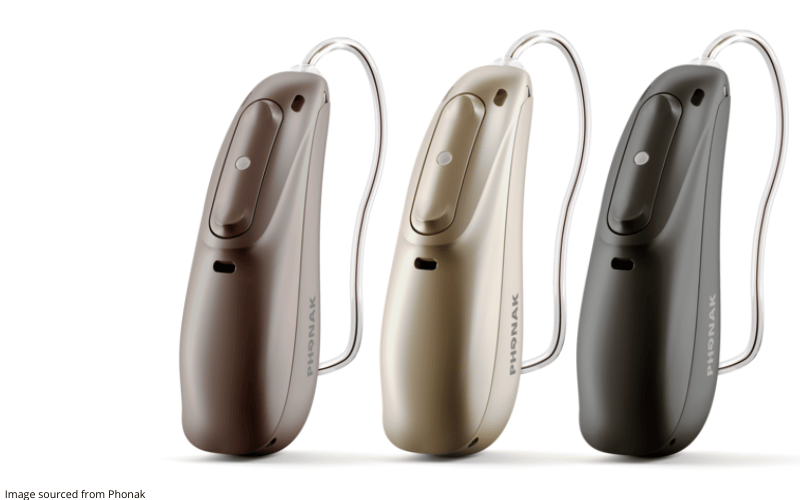
Phonak’s rechargeable hearing aid line is called the Phonak Audeo Lumity. The Audeo Lumity is the most recent flagship hearing aid developed by Phonak. It uses their newest operating system, AutoSense OS 5.0, which was developed with improved speech enhancement and microphone features in mind. The Lumity comes only in a rechargeable Receiver-in-Canal (RIC) model, with a push button, waterproof protection, and options for telecoil. Its built-in lithium-ion battery has been tested and is estimated to last 6 years.
The Phonak devices complete a 100% charge in only three hours, and last through a full day of wear. For faster charging, users can expect to see a 30% boost to the battery life within 30 minutes, and a 50% boost within 60 minutes. A full charge can be expected to last 18 hours, and a Phonak Charger Case Go holds an additional three charges and offers a portable charging option.
Different Phonak models come with various charging features. The Charger Case combo includes both a charger and a protective hard case, while the Powerpack allows for on-the-go charging. The Charger Case Go, designed specifically for the Audeo Life model, uses an inductive charger. Additionally, the Charge and Care system not only charges but also dries and treats the hearing aids, enhancing maintenance and longevity.
Beyond these charging capabilities, some Phonak rechargeable hearing aids come with advanced features. One notable feature is a telecoil, enabling users to connect directly to sound systems. Another is a noise generator, which is an effective tool for managing tinnitus, offering users additional comfort and functionality.
Oticon Rechargeable Hearing Aids
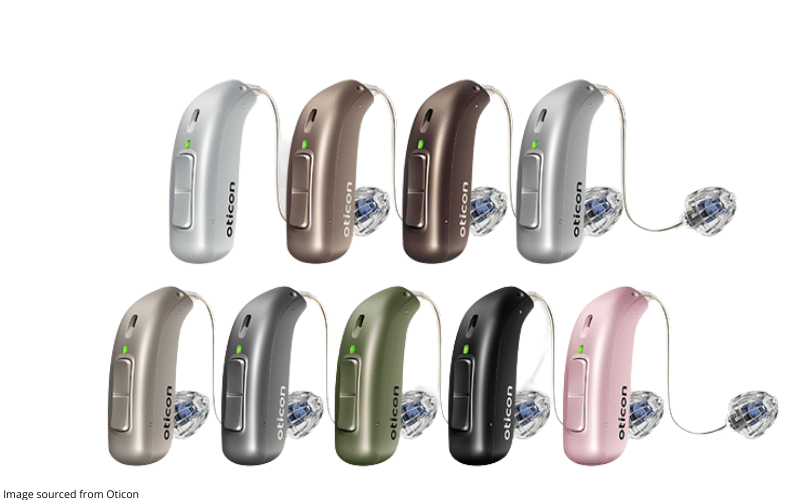
Oticon’s notable contribution to the hearing aid market is the Oticon Real, with two rechargeable models: the miniRITE R (receiver-in-the-ear) and the miniBTE R (behind-the-ear). Both models are equipped with telecoils and offer three technology levels. These aids use Oticon’s Smartcharger, ensuring a full day’s battery life of 16-22 hours, depending on usage. The aids require only three hours to fully charge, and a quick 30-minute charge can provide up to six hours of use. Under certain usage conditions, a full charge can extend up to 24 hours.
The Oticon desktop charger also delivers a full day’s battery life in three hours, maintaining performance even with streaming. However, lithium-ion battery life and performance may vary with daily use and diminish as the device ages. The SmartCharger doubles as a protective case and a power bank for on-the-go charging, also keeping the hearing aids dry and secure when not in use.
Oticon’s hearing aids are enhanced by the BrainHearing and Polaris sound processing platforms, along with artificial intelligence and Oticon’s Deep Neural Network technology. These innovations work together to improve sound quality, enhance speech comprehension, and support better sound processing within the brain. Additionally, Oticon offers tinnitus programming options to assist in managing tinnitus, adding to the comprehensive capabilities of their hearing aids.
Starkey Rechargeable Hearing Aids
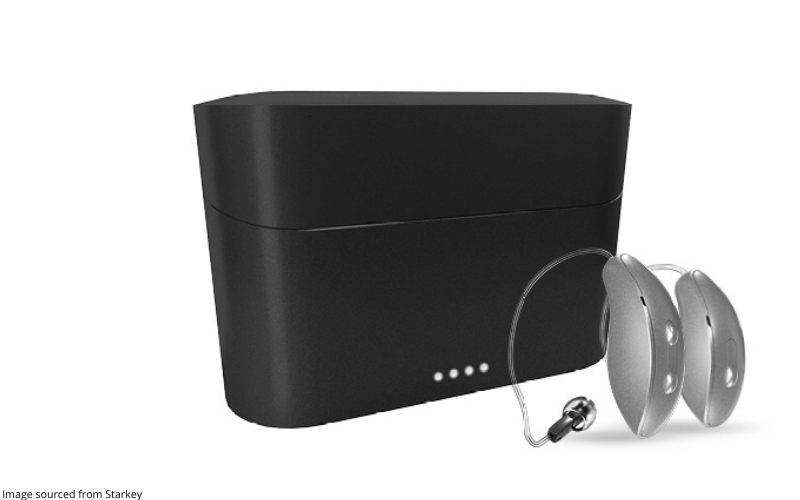
Starkey Hearing Technologies is one of the hearing aid manufacturers currently offering lithium-ion rechargeable hearing aids, including its Genesis AI and Evolv AI hearing aids. The Genesis AI rechargeable Receiver-In-Canal (RIC) hearing aid is notable for its advanced features: it makes 80 million personalized adjustments every hour, offers two-way audio for wireless connections, includes fall alert capabilities, language translation, and health and activity tracking. The StarLink Premium Mini Charger for this model can hold up to four charges, with a single charge providing up to 51 hours of power.
The charging efficiency of the Genesis AI is impressive: it takes only 3.5 hours to fully charge, and a rapid charge of just seven minutes offers three hours of battery life. The battery life is guaranteed for a minimum of four years. The Evolv AI and Livio AI models also have efficient charging capabilities, requiring less than three hours for a full charge. These models deliver 3.5 hours of battery life after just seven minutes of charging. On a full charge, they offer 24 hours of battery life, with the battery guaranteed for at least three years. Additionally, Starkey’s hearing aid models are equipped with features to assist in tinnitus management, adding to their utility.
Widex Rechargeable Hearing Aids
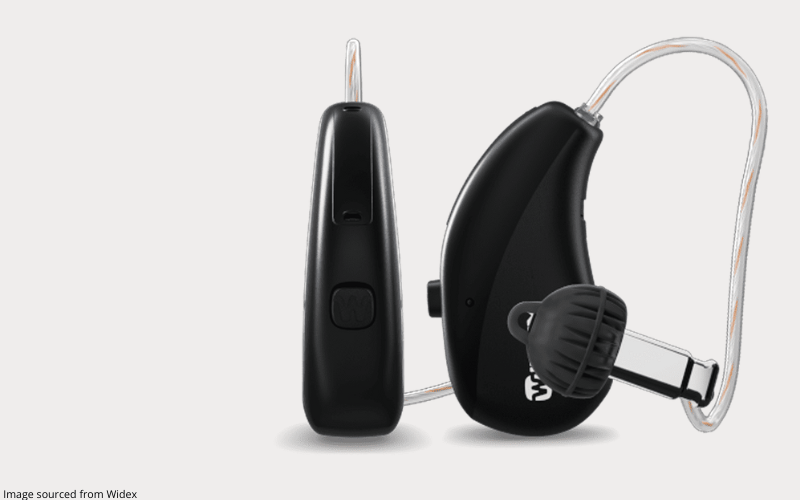
Widex Rechargeable hearing aids boast one of the smallest rechargeable lithium-ion receiver-in-canal (RIC) hearing aids: the Moment SHEER sRIC. It is the manufacturer’s second foray into this technology, after the mRIC, with a redesigned microphone port to improve the wearer’s ability to “hear,” process, and discern sounds in all environments, including complex and chaotic ones. The SHEER also comes with a sleek charger, with 29 hours of use delivered in four hours of charging (unless a full eight hours’ worth of use involves streaming, in which case a full charge delivers 16 hours of use). A 30-minute charge delivers four hours of use.
Widex offers a unique benefit: a tinnitus masking feature. Unlike standard masking devices, Widex boasts its own zen therapy, which uses musical chimes and tones to mask, rather than simple white or background noise. It helps manage tinnitus while easing some of the symptoms of stress and anxiety. While it is unique and can be beneficial, not everyone with tinnitus will like the musicality of the Widex programming.
ReSound Rechargeable Hearing Aids
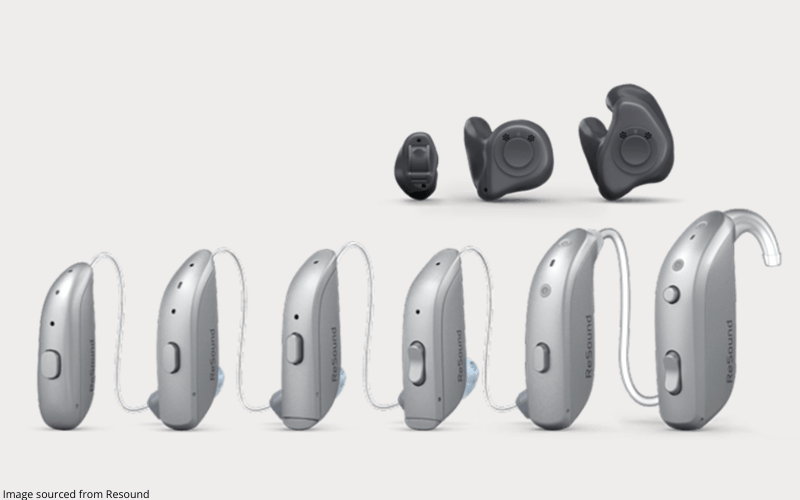
ReSound offers two rechargeable hearing aid models: the Nexia and the OMNIA. The Nexia, the latest model from ReSound, introduces Bluetooth capability and Auracast broadcasting for the first time. It is 25% smaller than its predecessors and features tap controls, a new addition compared to the earlier models without this feature. The OMNIA model stands out for its flexibility in styles and, like the Nexia, is equipped with technology to enhance hearing in noisy environments with lots of background “chatter.” Both models are compatible with three types of chargers: a desktop charger, a standard charger, and a premium charger. A full charge, taking three hours, provides 24 hours of typical use or 20 hours with extensive streaming (over 50% of the time). The premium charger can offer three full charges for two hearing aids.
The custom OMNIA device is tailored to fit the unique shape of the user’s ear and includes advanced features like twin directional microphones, Bluetooth connectivity, and high water resistance. Its charger is designed with custom inserts to match the ear mold shape, ensuring consistent electrical contact during charging. Additionally, these devices offer various sound masking options to effectively manage and mask tinnitus.
Signia Rechargeable Hearing Aids
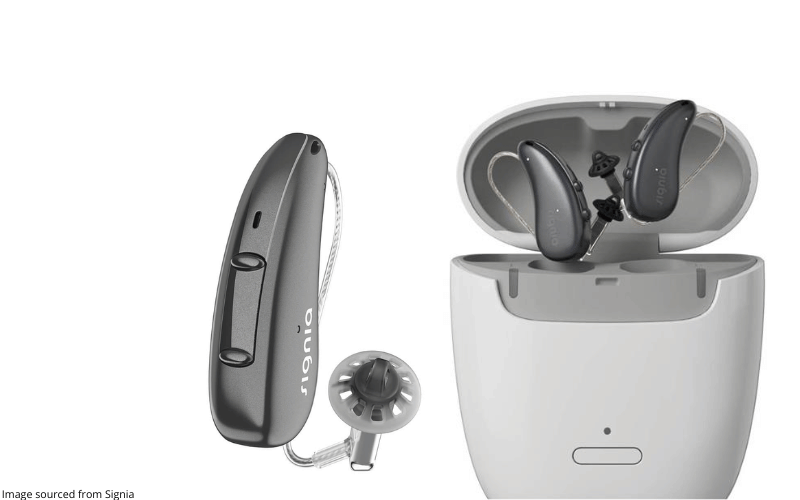
Signia rechargeable hearing aids include the Pure AX and the Pure IX. Named for its new “Integrated Xperience (IX)” platform, sound clarity and definition is said to be vastly improved for hearing aid wearers existing in dynamic, moving, and multi-speaker environments. Its “Augmented Xperience (AX)” platform offers streaming specifically for iOS and Android devices in order to provide hands-free use, alongside acoustic motion sensors and voice processing. Like many of its peers, there are three different chargers available for hearing aid wearers: the standard charger, the portable charger, and the dry and clean charger.
In part known for its innovative approach to technology, Signia was the first to introduce a wirelessly charged, custom, in the ear (ITE) hearing aid, to allow rechargeable hearing aids to be worn with greater discretion. In addition to its commitment to innovation in the realm of discretion, Signia technology comes equipped with the ability to partake of notch therapy and noise therapy to help manage symptoms of tinnitus.
OTC Rechargeable Hearing Aids
The FDA’s new over the counter (OTC) hearing aid category is good news for those seeking an OTC option for hearing aids, but not all OTC hearing aids actually make the list of legitimately FDA-cleared devices. There are aids that have been cleared, however, and most of them claimed rechargeability as an important selling point. The aids included on the list are as follows: Jabra Enhance Plus, Lexie Powered by Bose B2, HP Hearing Pro, Eargo 7, MD Hearing Volt Max, Lucid Engage, SoundWorldHD 75R, and the Go Prime.
Audicus Hearing Aids: The Best Budget-Friendly Rechargeable Hearing Aids
Audicus hearing aids are available in four models, each of them with their own unique pros and cons, and each available in either rechargeable or battery-operated options. We’ve identified the basics of each offering below:
Spirit 1 & 2: Receiver-in-canal (RIC)
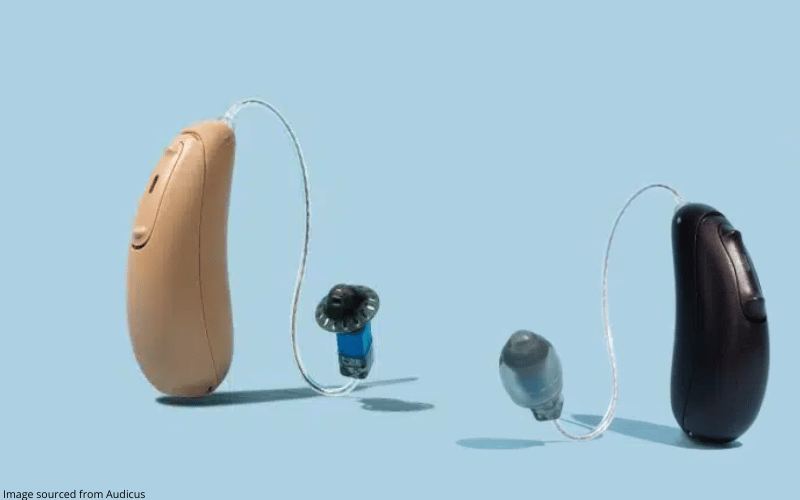
The Spirit 1 and 2 models differ primarily in size and Bluetooth connectivity; the Spirit 1 has only one connection option, and is a larger device. As a result, it is the cheaper of the two options, coming in at between $1,300 – $1,600 per pair. The Spirit 2 has two connection options and is the smaller and more discrete of the two, coming in between $1,700 – $2,000 per pair. Each is designed to be used for mild to moderate hearing loss, both come in either rechargeable or disposable options, and both are equipped with Bluetooth connectivity.
Omni 1 & 2: Receiver-in-canal (RIC)
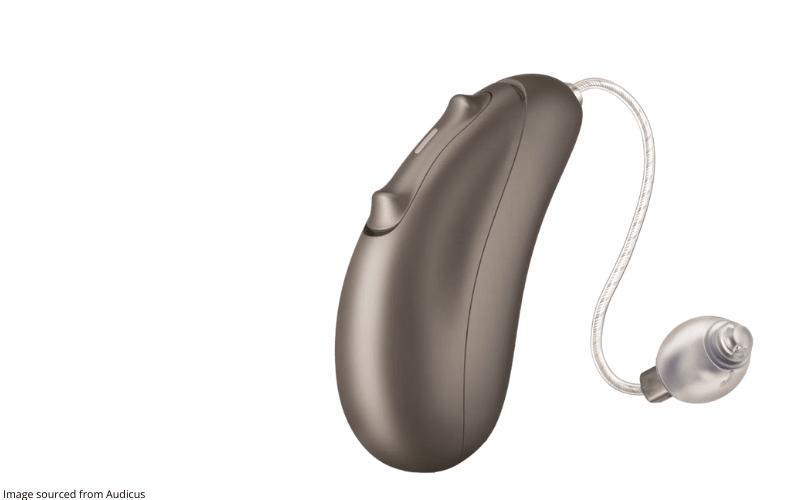
The Omni 1 and 2 models differ in processor speed and size, as well as Bluetooth options. The first, the Omni 1, offers a single Bluetooth connection option, and provides both Speech Finder technology and adaptive microphones. The Omni 2 is smaller, has a faster processor, and has two Bluetooth options. Both are intended for mild to moderate hearing loss, both come in rechargeable and disposable hearing aid options, and both have Bluetooth capability. The Omni 1 comes in at $2,300 – $2,600, while the Omni 2 comes in around $2,700 – $3,000 per pair.
Audien: Best Rechargeable Hearing Aids With Invisible Design
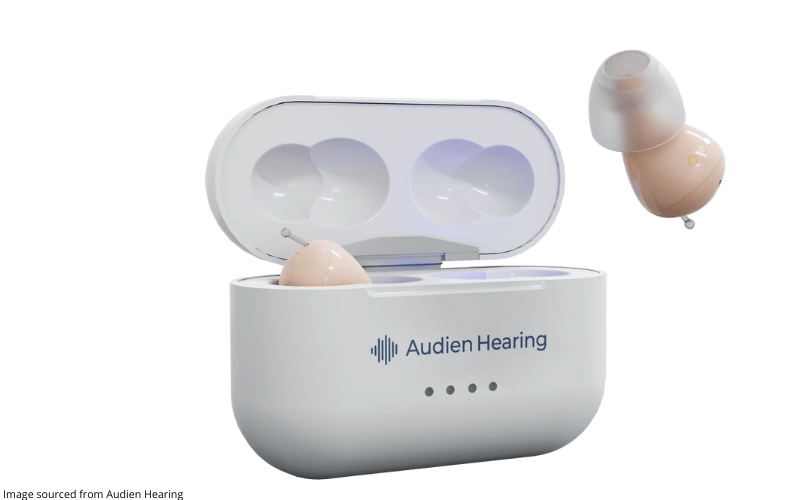
The Audien Atom 2 is the most recent offering from Audien. Clocked in at a size 28% smaller than the original design, the Atom 2 is named in part for its devotion to small size and discretion. Despite its small size, it boasts a 24-hour battery life, and starts at only $289 per pair. That being said, it is a basic hearing aid, focusing on amplification and noise cancellation, and does not offer options for tinnitus treatment or management like some of the other options listed here.
Most User-Friendly: Lexie B2 Powered By Bose
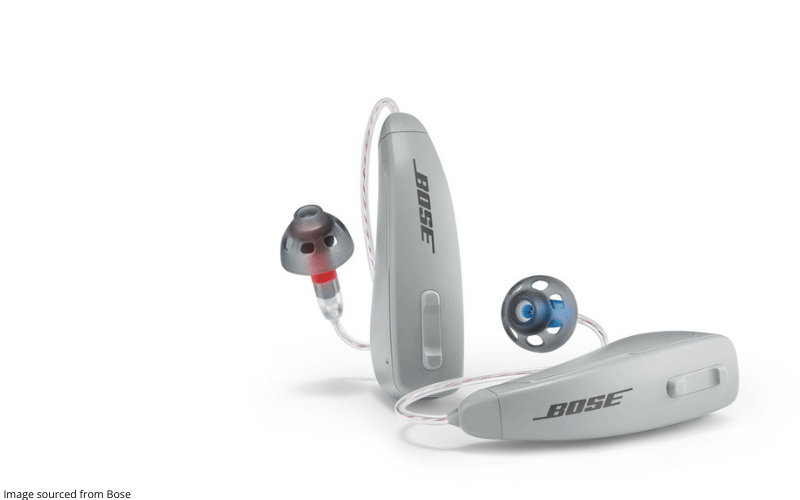
The Lexie B2 hearing aids powered by Bose provide a dedicated app for customization and use. They are billed as rechargeable, self-fitting, over the counter hearing aids, with Bluetooth capability. Powered by Bose and paired with the Lexie app, these hearing aids can be used to filter out sounds and amplify sounds. The streaming functionality of the Lexie B2 is specific to iPhones, so if you are in search of hands-free phone use, make sure your iOS is compatible. Coming in at around $900 for a pair, the Lexie B2 hearing aids are affordable, but do not provide the same sound masking and tinnitus management options that many professional, prescription-grade hearing aids provide.
How To Save Money On Rechargeable Hearing Aids
Although it can be tempting to immediately resort to purchasing the least expensive hearing aids on the market, it is important to consider the total cost of ownership of hearing aids when deciding between prescription and over the counter aids, and disposable battery-charged aids and rechargeable hearing aids. When shopping around for disposable batteries, you may find you can purchase them for as little as 30 cents each; however, if you use your hearing aids for around 16 hours each day, and you get 75 hours of use out of each battery, you will need approximately 150 hearing aid batteries each year, adding up to $50 per year for batteries, with a five-year cost of $250.
Most manufacturer warranties run for 2-3 years, but some offer warranties that specifically cover rechargeable batteries for extended periods. If your hearing aid is likely to be used for more than five years, having the rechargeable batteries replaced prior to the warranty expiration date can help prolong the life of your device. When comparing costs between rechargeable hearing aids and disposable battery fueled hearing aids, remember that the lifetime cost of batteries may actually bring costs even or slightly askew.
Before purchasing rechargeable hearing aids or button battery aids, make sure you check with your insurance and determine their policy for covering hearing aids. Getting ahead of this prior to purchasing can mean you save yourself a great deal of time and money. An audiologist is the hearing professional who can best discuss the best rechargeable hearing aid for you, or the best disposable hearing aid batteries that best suit your needs, according to the type and severity of your hearing loss, and your ultimate goals in utilizing a hearing device.





